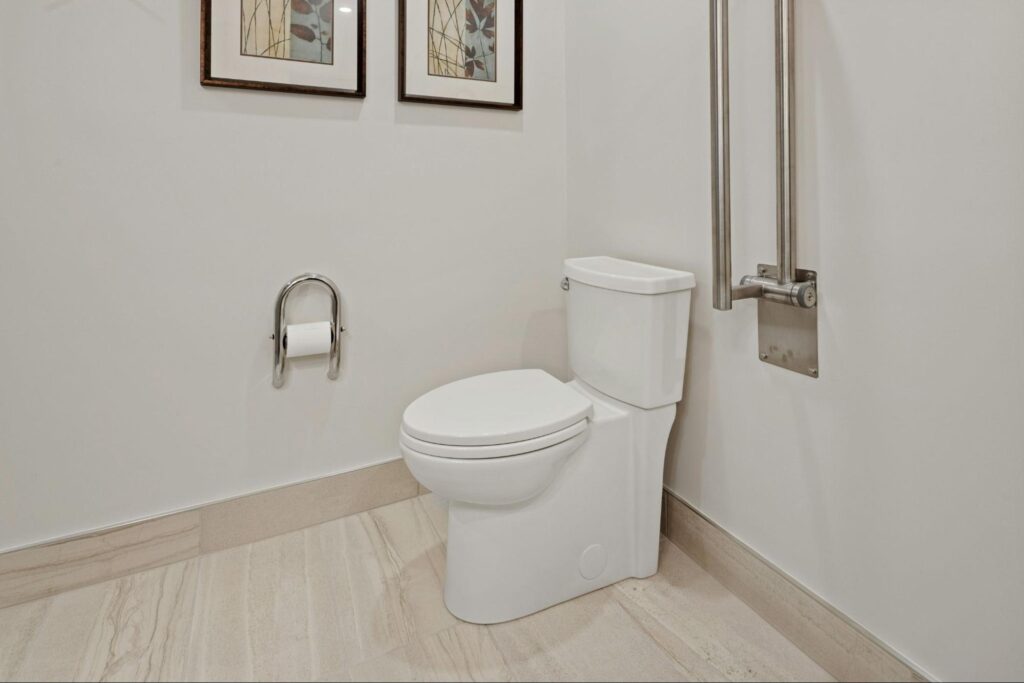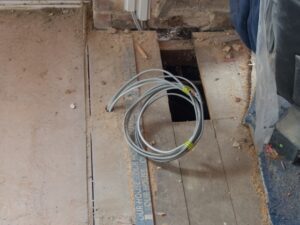If you’ve ever struggled with a toilet handle that is hard to flush, you’re not alone.
A common reason for this issue is a problem with the chain or the flapper, which can get tangled or misaligned. This simple fix can often solve the problem quickly and save you from frustration.
A handle that is difficult to flush might also be a sign of mineral buildup or worn-out parts inside your toilet tank. Regular maintenance can help prevent these issues and ensure your toilet functions smoothly. At Excel Mechanical, we provide expert plumbing services to address such concerns efficiently.
Whether it’s a small repair or a comprehensive plumbing solution, we offer exceptional quality and great value in both residential and commercial services. Our team is committed to ensuring your needs and budget are met with the best possible system.
In this blog, you will learn:
- The key components that might cause your toilet handle to be hard to flush.
- How to troubleshoot common issues with the toilet flush mechanism.
- The best solutions to fix a difficult-to-flush toilet handle without calling in a plumber.
Let’s get started!
Understanding Toilet Mechanics
Toilets are essential fixtures, and understanding their mechanics can help you fix common problems like a hard-to-flush handle. This section will explore the components and workings of the toilet flush system.
Components of the Toilet Flush System
A toilet’s flush system consists of several key parts.
- The fill valve controls water flow when the toilet is flushed.
- The flush valve releases water from the tank into the bowl.
- Inside the tank, a flapper lifts to release the water.
- The overflow tube prevents the tank from overflowing by directing excess water into the bowl.
- The float, which rises and falls with the water level, helps regulate the water in the tank.
Each part needs to work together for a smooth flush.
How a Toilet Handle Works
The toilet handle serves as the starting point for flushing.
When you press the handle, it lifts a chain or wire connected to the flapper. This movement allows water to rush from the tank to the bowl, flushing away waste.
If the handle is hard to flush, it might be due to a misaligned chain or a sticky pivot. Improperly adjusted chains can prevent the flapper from lifting fully, causing resistance.
Regular inspection and maintenance can help keep the handle functioning smoothly.
Common Reasons for a Hard-to-Flush Handle
A hard-to-flush toilet handle is a common issue caused by different problems. These include blockages in the flush pathway, problems with the flapper valve, and chain tension issues. Identifying these problems can help maintain your toilet’s efficiency.
Obstructions in the Flush Pathway
Obstructions are often to blame when a toilet handle is tough to flush.
Blockages can occur in the pipes, impeding the flow of water. This might be because of debris in the tank or mineral build-up. Over time, these materials can collect and restrict movement.
To fix this, check the tank for any foreign objects.
Inspect the flush mechanism and clean any visible debris. A regular cleaning routine can help prevent these issues and keep your toilet running smoothly.
Issues With the Flapper Valve
The flapper valve is a crucial component that controls water release.
If it becomes worn or misaligned, it can hinder flushing. Ensure the flapper seals properly after each flush. If it’s not sealing correctly, water may not flow as needed, causing the handle to resist.
Replacing a damaged flapper is often simple and affordable. Purchase a suitable replacement and follow installation instructions. A well-functioning flapper maintains efficient water use and a smooth flush.
Chain Tension Problems
The chain connecting the handle to the flapper can also impact the flush. If the chain is too tight or loose, it might not lift the flapper adequately, causing the handle to feel stiff or heavy when flushing.
To correct this, adjust the chain length. Make sure it’s neither too slack nor overly tight. When properly adjusted, the chain should allow the flapper to rise fully without excessive effort on the handle.
Troubleshooting Steps
A toilet handle that’s hard to flush can be frustrating. To resolve this issue effectively, you need to inspect for obstructions, adjust the lift chain, and test the flapper valve.
Inspecting for Obstructions
Start by taking off the toilet tank lid and look inside the tank.
You may find debris, broken parts, or mineral buildup, causing the handle to be hard to flush. Examine the handle mechanism by loosening or tightening screws and fittings if necessary. Clear any debris that might be hindering movement.
Sometimes, mineral deposits build up around the handle mechanism. You can clean these deposits with a mild cleaner. If you’re unsure or need extra help, consider contacting experts for professional assistance with your plumbing needs.
Adjusting the Lift Chain
Check the lift chain attached to the flush handle and the flapper.
It could be too tight or too loose, impacting how well your toilet flushes. When the chain is too tight, there might not be enough slack for proper flushing. If it’s too loose, it might not lift the flapper fully.
Adjust by removing chain links or reconnecting the chain at a different point. Aim for about half an inch of slack. This adjustment ensures the flapper can lift efficiently.
Testing the Flapper Valve
Your flapper valve might be the culprit if it’s sealing improperly or is worn out. Gently lift the flapper to see if the toilet refills. A good flapper should form a tight seal.
If it appears damaged or warped, replace it with a new one. Make sure you select the right size and type for your toilet. Testing a new flapper can significantly improve the flush handle operation.
By following these steps, you can address a hard-to-flush toilet handle effectively.
Repair and Replacement Solutions
When your toilet handle is hard to flush, it might be due to several issues, such as a broken handle, a warped flapper, or an incorrect chain length. These problems can often be fixed with simple tools and some basic steps.
Replacing a Broken Handle
If the handle is broken, replacing it is usually the best solution.
- First, purchase a new handle from a hardware store. Make sure it is compatible with your toilet model.
- Begin by removing the nut inside the tank holding the handle. This nut is typically reverse-threaded, so twist it clockwise to loosen it.
- Once removed, slide the old handle out.
- Insert the new handle through the hole and secure it with the nut.
- Tighten the nut by turning it counterclockwise.
- Attach the chain to the lever of the new handle, ensuring it’s not too tight or loose.
- Test the handle by flushing it to make sure everything works smoothly.
Fixing a Warped Flapper
A warped flapper can prevent the toilet from flushing properly.
- To fix this, turn off the toilet’s water supply. Then, flush to empty the tank.
- Remove the old flapper from the overflow tube inside the tank. You may need to unhook the chain from the flapper.
- Check for any signs of warping or damage.
- Purchase a new flapper and install it by attaching it to the overflow tube.
- Connect the chain to the flapper, ensuring the correct tension.
- Turn the water supply back on and test the flush to ensure the problem is resolved.
Correcting Chain Length and Hook Position
Chain length and hook position are crucial in ensuring the toilet flushes properly.
- First, open the tank and observe how the chain operates during a flush.
- If the chain is too loose, it may not lift the flapper enough. Adjust the chain length by shortening it slightly. Make sure the hook is securely attached to the flapper.
- If the chain is too tight, the flapper won’t seal, causing the toilet to run. Lengthen the chain a bit to give it some slack.
By making these simple adjustments, you can often resolve any issues with a hard-to-flush toilet handle.
Preventive Maintenance and Regular Care
Taking care of your toilet’s handle to ensure ease of flushing involves two essential practices: routine cleaning and checking the components for any need for lubrication or adjustments. Maintaining these areas helps avoid common issues and ensures smooth operation.
Routine Cleaning Recommendations
Keep the toilet’s external parts clean to prevent buildup affecting the handle’s function.
Use a mild bathroom cleaner to regularly wipe down the toilet handle and surrounding area. Make sure to get into any small crevices where dirt might gather.
If you notice any rust or mineral deposits on the handle, a gentle scrub with a soft brush and a mixture of vinegar and water can help remove these stubborn spots. It’s important to address these areas promptly, as they can lead to more significant problems if ignored.
Regular cleaning reduces the risk of malfunction and can prolong the life of your toilet’s components.
Lubrication and Component Checks
Regularly check the internal workings of the toilet handle mechanism for signs of wear or parts that might need lubrication. Focus on the flush lever and chain to ensure they move smoothly. Apply a suitable lubricant to any metal parts if you notice stiffness or resistance.
Inspect for any loose or worn parts that might require replacement. Tighten any loose components and replace broken ones before they cause further damage.
An essential part of maintaining toilet handle functionality is ensuring the parts work together without friction or obstruction.
Professional Assistance
Sometimes, a stubborn toilet handle needs expert help.
You might wonder when to seek professional services and how to find the best plumber for the job. This guide provides clear criteria for calling a plumber and tips for choosing qualified services efficiently.
When to Call a Plumber
If your toilet handle is hard to flush, it could be due to a worn-out flapper or a damaged chain. If you’ve tried basic troubleshooting and the problem persists, it’s time to call a plumber.
Professionals can quickly diagnose more complex issues, saving you time and potential damage to your plumbing system.
Ignoring these problems might lead to higher water bills or more serious repairs in the future.
Finding Qualified Plumbing Services
When seeking help, look for licensed professionals with experience in toilet repairs.
Recommendations from friends and online reviews can guide you to reliable services. However, to ensure quality work, it is essential to verify that the service offers guarantees or warranties.
Consider using Excel Mechanical for your plumbing needs.
Known for exceptional quality and value, we offer customized solutions that suit your budget and requirements. Our skilled team ensures top-notch service for both residential and commercial needs.
Toilet Technology Advancements
Modern toilets have seen impressive advancements. These changes make using and maintaining toilets easier and more efficient.
- Smart Toilets: With features like automatic flushing, heated seats, and bidet functions, you can enjoy increased comfort and hygiene. Some even offer hands-free control with voice commands.
- Water Efficiency: Dual-flush systems help save water by offering two flush options. This reduces water usage without compromising performance.
| Feature | Benefit |
| Smart Sensors | Detect flush needs |
| Dual-flush | Saves water |
| Touchless Flush | Enhances sanitation |
- Eco-friendly Options: Toilets that use less than 1.28 gallons per flush are becoming more common. These models help reduce water bills and conserve natural resources.
- Comfort Features: Innovations like air purifiers and night lights are now available. These features add convenience and enhance user experience.
With ongoing advances, toilets are becoming more user-friendly and resource-efficient.
Environmental Considerations
You might consider some environmental impacts when your toilet handle is hard to flush. Fixing this issue often helps save water. A toilet requiring multiple flushes wastes more water, increasing utility bills and affecting water conservation efforts.
Efficient flushing systems can significantly reduce water usage. Modern toilets are designed to use less water per flush, which helps conserve valuable resources. If your toilet struggles due to mechanical issues, upgrading to a more efficient model might be time.
Recycling and disposal of old plumbing parts are essential. If you replace components like the handle or internal mechanisms, ensure they’re disposed of correctly. Some parts can be recycled, lowering the environmental burden and supporting sustainability efforts.
Choosing the right service provider is crucial.
With Excel Mechanical, you receive exceptional quality and great value. We work to provide systems that meet individual needs and budgets, ensuring your plumbing is efficient and environmentally responsible.
Frequently Asked Questions
When it comes to a toilet handle that’s hard to flush, it can leave you wondering what’s causing the issue and how to fix it. Don’t worry — you’re not alone! Let’s dive into some common questions and help you troubleshoot.
What could cause a toilet handle to become difficult to operate?
Over time, mineral buildup, wear and tear, or misalignment can make a handle hard to use. Check for corrosion around any metal parts, as that might be a problem.
How do I troubleshoot a toilet handle that requires excessive force to flush?
First, inspect the handle and the chain connecting it to the flapper for visible damage. Ensure the chain isn’t too loose or tangled, and adjust if needed.
Can a malfunctioning flapper valve affect the ease of flushing a toilet?
Yes, a worn or misaligned flapper valve can make flushing difficult and lead to incomplete sealing, which affects water flow.
Are there common issues with American Standard toilets that lead to hard flushing?
American Standard toilets might experience issues similar to those of other brands, like mineral buildup or misalignment. Regular maintenance can help prevent these problems.
Is there a way to fix a toilet that is hard to flush without replacing parts?
Yes, often cleaning or gently adjusting parts can solve the issue. Lubricating moving parts may also help make flushing smoother.
What should be checked if a toilet’s flush is weak and the handle is tough to push down?
Check the tank’s water level and ensure the float and flush valve are working correctly. You may need to make adjustments.




